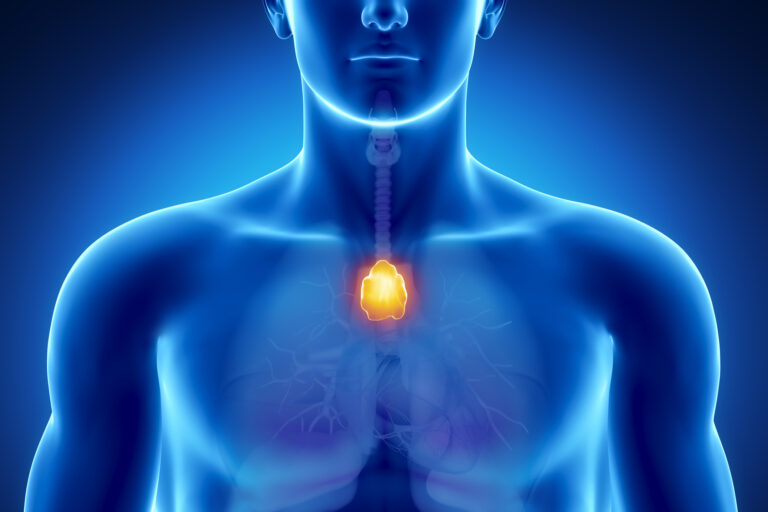
Myasthenia gravis (MG) is a neuromuscular autoimmune disorder that causes weakness in the skeletal muscles. An autoimmune disorder is when the immune system mistakenly attacks your body’s healthy cells. The associated fragility worsens after activity and improves after rest.
The term “myasthenia gravis” has Greek and Latin origins, meaning “serious or grave muscle weakness.” Although no cure is available for this autoimmune disease, existing treatments have made myasthenia gravis manageable. With current therapies, patients can control their symptoms and experience an improved quality of life.
Get Your IVIG Dose
At-Home InfusionCauses of Myasthenia Gravis
Antibodies
Neurotransmitters are chemicals released by nerve endings to communicate with the muscles to cause contraction. These neurotransmitters attach to receptors over the muscle cells at the nerve-muscle junction.
MG is what occurs when your immune system causes your antibodies to damage or block acetylcholine receptor sites in your muscles. Ase a result, very few receptor sites are available, and fewer nerve signals are received by your muscles, leading to weakness and less contraction.
This disease may also occur when antibodies restrict the activity of a protein called muscle-specific receptor tyrosine kinase (MuSK). This protein is responsible for nerve-muscle junction formation. When antibodies attack this protein, it can lead to myasthenia gravis.
Lastly, MG disease may occur when antibodies work against a protein, lipoprotein-related protein 4 (LRP4).
Studies have shown other antibodies’ involvement as causative factors, and they expect their number to rise.
Myasthenia gravis doesn’t develop in some patients due to antibodies blocking acetylcholine, LRP4, or MuSK. This kind of condition is what is known as seronegative MG or antibody-negative. Researchers believe that while this type of myasthenia gravis doesn’t appear to involve antibodies, it still has an autoimmune basis.
Thymus Gland Disorders
The thymus gland can be found underneath the breastbone in the upper chest region as part of your immune system. Researchers believe that the thymus gland activates or mediates antibody production, which blocks acetylcholine.
The thymus gland is large in infants, and its size reduces with age, becoming small in healthy adults. However, in some people with myasthenia gravis, the thymus gland’s size becomes abnormally large. Certain patients of MG disease can also have thymus gland tumors called thymomas.
Other Causes
In rare cases, mothers with myasthenia gravis have children born with the disorder (what is known as neonatal MG). If treated promptly, children generally recover within two months after birth.
Some children are born with a rare, hereditary form of myasthenia gravis, called congenital myasthenic syndrome.
Some factors can exacerbate myasthenia gravis. These include:
- Illness or infection
- Fatigue
- Stress
- Surgery
- Medications – beta-blockers, quinidine sulfate, quinidine gluconate, quinine (qualaquin), phenytoin, some anesthetics, and antibiotics
- Menstrual periods
- Pregnancy
Get IVIG Copay Assistance
Your IVIG Treatment Info | Get IVIG Prior AuthorizationWhat Are the Symptoms of Myasthenia Gravis?

The primary symptom of MG is what allows you to detect the disease. And that symptom is the weakness of voluntary muscles, which are muscles under your control. Muscles may fail to contract generally due to their inability to respond to nerve impulses. Because of the lack of impulse transmission, blockage occurs in the communication between muscles and nerves, resulting in weakness. This weakness generally worsens with activity and improves with rest.
Other symptoms of MG disease can include:
- Fatigue
- Hoarse voice
- Difficulty speaking
- Facial weakness
- Problems breathing because of muscle weakness
- Difficulty swallowing
- Double vision
- Drooping of eyelids
These symptoms might not be present in every patient, and the severity of muscle weakness may vary each day. If not treated in time, the severity of the symptoms becomes worse. The worsening of these symptoms is what makes MG so unbearable.
Complications
While the complications of myasthenia gravis are generally manageable, some can be lethal.
Myasthenic Crisis
The weakening of the muscles that control breathing leads to a complication called a myasthenic crisis. Myasthenic crisis is a life-threatening condition that happens because of the location of these muscles in the airways. In such cases, emergency intervention and mechanical support for breathing become necessary. With medications and blood-filtering treatments, patients can start breathing on their own.
Thymus Gland Tumors
In some patients, MG is what occurs due to a thymus gland tumor (thymoma). Although most of these tumors are not malignant, some may become cancerous.
Other Disorders
Individuals who have myasthenia gravis are more susceptible to other disorders, which can include:
- Overactive or Underactive Thyroid – The thyroid gland, situated in the anterior part of your neck, has a vital role in secreting thyroid hormone, thus regulating metabolism. An underactive thyroid might cause problems, including feeling cold, weight gain, etc., while an overactive thyroid may cause problems with feeling excessive heat, weight loss, etc.
- Autoimmune Conditions – Individuals with MG disease may be more prone to have autoimmune conditions such as lupus or rheumatoid arthritis.
Get IVIG Prior Authorization
How Is Myasthenia Gravis Diagnosed?

Your clinician will suggest various tests to confirm what you’re suffering from is MG.
Physical and neurological examination
Your clinician will review your medical history and carry out a physical examination. A neurological exam includes checking muscle tone, strength, coordination, sense of touch, and looking for eye movement issues.
Blood Test
Blood tests check for elevated levels of specific antibodies in the blood, including acetylcholine receptors and anti-MuSK antibodies. However, some people with myasthenia gravis may not have these antibodies (they may have what is known as seronegative MG).
Electrodiagnostics
Repetitive nerve stimulation may also be necessary to check for the stimulation of the patient’s nerves. In patients with MG disease and other neuromuscular disorders, muscles don’t respond to repetitive electrical stimulation as well as in healthy individuals. The most sensitive test for MG is single-fiber electromyography (EMG), which perceives diminished nerve-to-muscle transmission. If what you have is a mild case of MG, this test can help diagnose it when other tests do not successfully demonstrate abnormalities.
Diagnostic Imaging
Magnetic resonance imaging (MRI) or Computed tomography (CT) of the chest can help identify thymoma or other abnormalities in your thymus.
Pulmonary Function Testing
Respiratory failure can be checked by measuring breathing strength. Respiratory failure may cause a myasthenic crisis.
Weakness is a common symptom of several disorders. A diagnosis of myasthenia gravis can be delayed or missed in individuals with mild weakness in the airways or in those who have weakness locally in a few muscles.
Can IVIG help?
Free IVIG Treatment Info | Difficulty In Diagnosing?What is the Treatment of MG?
Several single or combination treatments may alleviate symptoms of MG disease. The treatment you will receive depends on your age, the severity of your disorder, and disease progression.
Medications
Cholinesterase Inhibitors
Cholinesterase Inhibitors, including pyridostigmine, are used to improve communication between muscles and nerves. These medications do not cure the condition but can enhance muscle strength and contraction in some patients. Their side effects can include diarrhea, gastrointestinal upset, nausea, and extreme sweating and salivation.
Corticosteroids
Prednisone obstructs the immune system and limits the production of antibodies. However, long-term corticosteroid use can lead to severe side effects, including weight gain, bone thinning, diabetes, and an increased risk of infections.
Immunosuppressants
Immunosuppressants regulate your immune system, and this is what can treat your MG. They include medications such as eculizumab, rituximab, azathioprine, mycophenolate mofetil, cyclosporine, methotrexate, or tacrolimus. Adverse effects of immunosuppressants include elevated risk of infection and kidney or liver damage.
Intravenous Therapy
Intravenous therapy is another treatment option for myasthenia gravis used short term to alleviate the rapid deterioration of symptoms. It may also be used before surgery.
Plasmapheresis
In this process, a filtering procedure similar to dialysis is used. Blood passes through a machine that eliminates the antibodies obstructing signal transmission from the nerve endings to muscles’ receptor sites. This is what treats your MG. The risks of plasmapheresis include a decrease in blood pressure, heart rhythm problems, bleeding, or muscle cramps. Some individuals may develop an allergic reaction due to the compounds found in the plasma replacement.
Intravenous Immunoglobulin (IVIG)
Your body gets normal antibodies with IVIG treatment, which plays a role in altering your immune response. The benefits of IVIG for myasthenia gravis are usually seen within a week and may last for three to six weeks. Side effects are typically mild and can include dizziness, chills, fluid retention, and headaches.
Get IVIG Copay Assistance
Speak to a SpecialistSurgery
Some individuals with MG disease may have a thymus gland tumor. In such cases, a thymectomy will be performed (i.e., surgical removal of the thymus gland).
Even without a thymus gland tumor, thymectomy may improve myasthenia gravis symptoms. Nonetheless, thymectomy benefits may take some years to show progress.
The thymectomy procedure involves open or minimally invasive surgery. The open surgery procedure, which is what is used to treat MG, involves splitting the sternum (central breastbone) to open your chest and remove the thymus gland. Minimally invasive surgery to remove the thymus gland uses smaller incisions. It might also involve:
- Video-Assisted Thymectomy. A small incision is placed on your neck, or a few small incisions are made on the side of the chest. A long, thin camera called a video endoscope is used to view and remove the thymus gland.
- Robot-Assisted Thymectomy. Small incisions are placed on the side of your chest to remove the thymus gland with the help of a robotic system comprising a camera arm and mechanical arms.
Minimally invasive procedures may cause less pain, less blood loss, lower mortality rates, and shorter hospital stays vs. open surgeries.
Lifestyle and Home Remedies
You should adjust your lifestyle to make the most of your energy and help cope with the symptoms of MG disease.
Adopt the Right Eating Routine
Chew your food properly and eat meals when you have good muscle strength. Try to take breaks between bites. Eating smaller portions a couple of times a day might also help. In addition, eat soft foods and avoid hard foods that require more chewing.
Practice Safety Precautions at Home
Try to prevent falls by installing railings or grab bars in areas where support is needed, including next to the stairs or bathtub. Your floors should be kept tidy, and remove area rugs. Keep your sidewalks and driveways clear of snow, leaves, and other rubble that may cause you to trip.
Utilize Electric Appliances and Tools
Technology is what can help you live more comfortably with MG. To preserve your energy, use electric can openers, toothbrushes, and other electrical appliances for performing tasks.
Wear an Eye Patch
Eye patches can help alleviate double vision. Wear an eye patch, especially when writing, reading, or watching TV. Also, shift the eye patch to the other eye periodically to reduce eyestrain.
Plan
Plan shopping or other tasks when you have the most energy.
Coping and Support
Living with MG disease can be challenging as it turns the body against itself. The condition can worsen due to stress, so you should explore methods to help you relax. Now that you know what MG is, don’t hesitate to ask for help when needed.
REFERENCES:
- Anonymous. Myasthenia Gravis. John Hopkins Medicine. https://www.hopkinsmedicine.org/health/conditions-and-diseases/myasthenia-gravis
- Mayoclinic staff. Myasthenia Gravis. Mayoclinic. Jun 2021. https://www.mayoclinic.org/diseases-conditions/myasthenia-gravis/symptoms-causes/syc-20352036
- NIH Staff. Myasthenia Gravis Fact Sheet. NIH. Apr 2020. https://www.ninds.nih.gov/Disorders/Patient-Caregiver-Education/Fact-Sheets/Myasthenia-Gravis-Fact-Sheet+
- Weatherspoon D. Myasthenia Gravis. Healthline. Sept 2018. https://www.healthline.com/health/myasthenia-gravis













